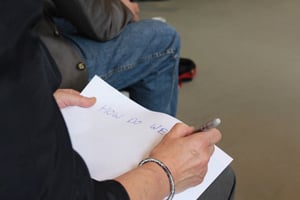The tough get going
Losing local authority funding hasn’t meant the end of the road in Gloucestershire – quite the reverse. Pippa Jones explains why

During 2010 Gloucestershire County Council (GCC) made it clear to the arts sector that their financial support would gradually be reduced in the coming years. It was a message that was mirrored by a similar stark message from the six District Councils.
This challenge was the catalyst that ultimately led to the setting up of Create Gloucestershire, an arts sector-led development hub with a mission to put art in the heart of Gloucestershire.
This change process was initially led by six Chief Executives from key arts organisations in the county, and I was soon appointed to explore whether collaboration could sustain the arts sector as funding started to dwindle. My starting point was to find out what people valued about the arts in Gloucestershire and why. Top of the poll was the diversity and spread of artists and arts organisations, in terms of profile, artform, turnover and geographical spread. Sustaining and refreshing this arts ecology required a paradigm shift in thinking away from a focus on sustaining a few regularly funded organisations towards a wider commitment to nurture a “regularly funded arts habitat”*.
In 2011 GCC announced details of its plans – to reduce overall spend by 30% from 2012 with a similar trajectory thereafter. Large parts of Council-funded activity deemed ‘discretionary’ would cease altogether – including Life Long Learning, the department that for eight years had managed arts development. We had two scenarios to consider – firstly that if arts funding survived, the 30% cut would be ‘salami sliced’ with no strategic intent. Secondly, that it would be cut altogether as had recently happened in Somerset. Both options had very serious implications for the sector, especially for smaller arts venues in isolated rural areas.
So we approached the Council with an alternative, which was to outsource arts development to a new arts sector-led organisation. In practice this meant GCC arts grants, previously given to 12 individual organisations, would be pooled and invested against a set of collectively agreed development priorities. GCC made three provisos:
- That our development plan had the support of all the organisations currently in receipt of a County Council arts grant
- That we could demonstrate a 30% saving on current arts spend in 2011/12, tapering to zero by 2014
- That funding must be spent on innovation, based on collective working and diversification of income, and not support the status quo.
Negotiations began and were inevitably difficult for everyone involved, immersed at that point in a time of unprecedented change and financial uncertainty. In the end the model for Create Gloucestershire, of an organisation with the ‘bigger picture’ in mind, acting as a single portal for funders and strategy-makers, had sufficient mileage for the three provisos to be met.
Create Gloucestershire was registered as a not-for-profit company in August 2011 with a financial settlement from GCC in 2011/12 of £124k, reducing to £83k in 2012/13 and £41k in 2013/14. To this some joint arts funding from District Councils of £19k was added. Then, on 31 March this year, Helen Owen, the County Arts Development Manager seconded to Gloucestershire until this point, retired. We moved into uncharted territory with no County Council Officer or politician in charge of arts and culture. Only one of the six District Councils (Cheltenham Borough Council) still has an Arts Development Officer – this function subsumed in the case of the remaining five districts into more generic Cultural Services posts. GLOSS, the county arts education agency was also cut during this period.
We are still working out what this change means. In a recent meeting of artists and venues to explore an ambitious cross-sector project, somebody asked “do we have authority to do this?” It took a few moments for it to sink in that we did.
We have used two Open Space events, an online survey and many conversations to ask as many people as possible ‘How Do We?’ A synthesis of the answers is our recently published Manifesto. This has eight pledges ranging from artist support to accessibility for audiences to arts education, and marketing. This acts as our ‘magnetic north’, a description for us and for others of our vision for a regularly funded arts habitat in Gloucestershire. We are now inviting others to sign the manifesto and join forces with us – artists and arts organisations, but also anyone else who cares about the arts in Gloucestershire and is willing to take some responsibility for action
There are encouraging early signs that our model is working. We have just secured £374k from GCC for a countywide arts project to support children in situations of domestic violence, to be delivered by a consortium of arts venues. With our partner members, we have secured £63k from Gloucestershire Assembly to help sustain inclusive arts expertise in the county in the face of loss of core funding for key organisations in this field. And R&D leading to a joined-up countywide arts education offer is well underway.
My job as Development Director is to manage difference ‘into’ and not ‘out of’ Create Gloucestershire, amplifying the specific and the unique that each artist and arts organisation contributes to the overall value chain. This is not easy, but critical to sustain the diversity of the arts ecology in the county identified as being so valuable at the start of this journey.
Join the Discussion
You must be logged in to post a comment.